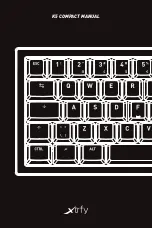
Editing Conventions
Deleting Objects
5-4
||||||||||||||||||||||||||||||||||||||||
||||||||||||||||||||||||||||||||||||||||
||||||||||||||||||||||||
||||||||
||||||||
Save|Righteous|Piano|as:
|ID#200|
||||||||
||||||||||||||||||||||||||||||||||||||||
||||||||||||||||||||||||||||||||||||||||
||||||
||||||||||||||
||||||
|
||||||
|
||||||
Object
||||||||||||||
Rename
|
Save||
|
Cancel
ROM Objects
If the object you started from was a ROM (factory preset) object, the K2vx will automatically
suggest the next available (unused) ID as the ID for the edited object. If thatÕs the ID you want,
press the
Save
soft button, and the object will be stored in RAM with that ID. Otherwise, you
can select any ID from 1 to 999. This screen also gives you the opportunity to return to the
naming dialog (as described in the previous section) or, by pressing the
Object
soft button, to
access the Object Utilities (described in Chapter 13 of this manual).
If you select an ID thatÕs already in use, the K2vx will tell you that youÕre going to replace the
ROM object thatÕs already been assigned that ID. If you donÕt want to do that, you can select a
different ID. Or you can press the Plus/Minus buttons simultaneously to toggle between the ID
that the K2vx suggested and the original ID. Or press the
Cancel
soft button to cancel the
operation.
If you decide not to cancel or change the ID, and you press the
Replace
soft button, the K2vx
will write your newly edited object over the existing ROM object. Actually, it only appears that
way, since you canÕt truly write to ROM. The ROM object will reappear if you delete the newly
edited object (there are soft buttons in each editor for deleting objects).
RAM Objects
If the original object was a RAM object, the K2vx will assume you want to replace it, and will
suggest the same ID as the original object (if it has an asteriskÑ
*
Ñbetween its ID and its name,
itÕs a RAM object. As with ROM objects, you can cancel, replace, or change the ID and save to
an unused ID. If you replace a RAM object, however, itÕs deÞnitely gone!
Deleting Objects
Within most editors, there are soft buttons for deleting objects. When you want to delete an
object, press the
Delete
soft button, and the K2vx will ask you if you want to delete the object.
Press
OK
if you want to delete it, or press
Cancel
if you donÕt. Although it seems that you can
delete ROM objects, you canÕt actually do it. The K2vx will behave as if itÕs deleting the ROM
object, but it will still be there the next time you select it. (What actually happens is that the
ROM object is copied to RAM as soon as you press EDIT, and when you ÒdeleteÓ the ROM
object, youÕre actually deleting the RAM copy. The original ROM object remains in memory.)
RAM objects, on the other hand, are
gone
when you delete them! If youÕve ÒreplacedÓ a ROM
object by saving a RAM object with the same ID, the ROM object is invisible, but still there.
Deleting the RAM object stored at the same ID will restore the ROM object.
You can use the Delete function to delete any object from the current list of objects. After you
press the
Delete
soft button, use one of the data entry methods to select any other object in the
current list of objects. Then press
Delete
again. YouÕll often delete objects to gain RAM space, or
to organize the
memory banks
before saving objects to disk. To delete multiple objects, use the
Delete Objects utility available in Master mode. ItÕs described on page 11--9.
Summary of Contents for K2500RS
Page 12: ...Table of Contents TOC 12...
Page 16: ...Introduction How to use this manual 1 4...
Page 32: ...User Interface Basics The Panel Play Feature K2vxR 3 8...
Page 106: ...Effects Mode and the Effects Editor Configurations and Parameters 9 24...
Page 186: ...Song Mode Recording Multi timbral Sequences via MIDI 12 52...
Page 304: ...DSP Functions Hard Sync Functions 14 52...
Page 394: ...Programs Setups and Keymaps K2500 ROM Keymaps 21 12...
Page 402: ...LFOs LFO Shapes 23 4...
Page 406: ...Note Numbers and Intonation Tables List and Description of Intonation Tables 24 4...
Page 434: ...DSP Algorithms 26 14...
Page 450: ...MIDI and SCSI Sample Dumps SMDI Sample Transfers 29 8...
Page 464: ...Glossary 31 6...
Page 490: ...K2vx Program Farm VOX K25 Appendix A 22...
Page 494: ...K2vx Compatibility Converting programs from the K2vx to K2000 Appendix B 4...
















































